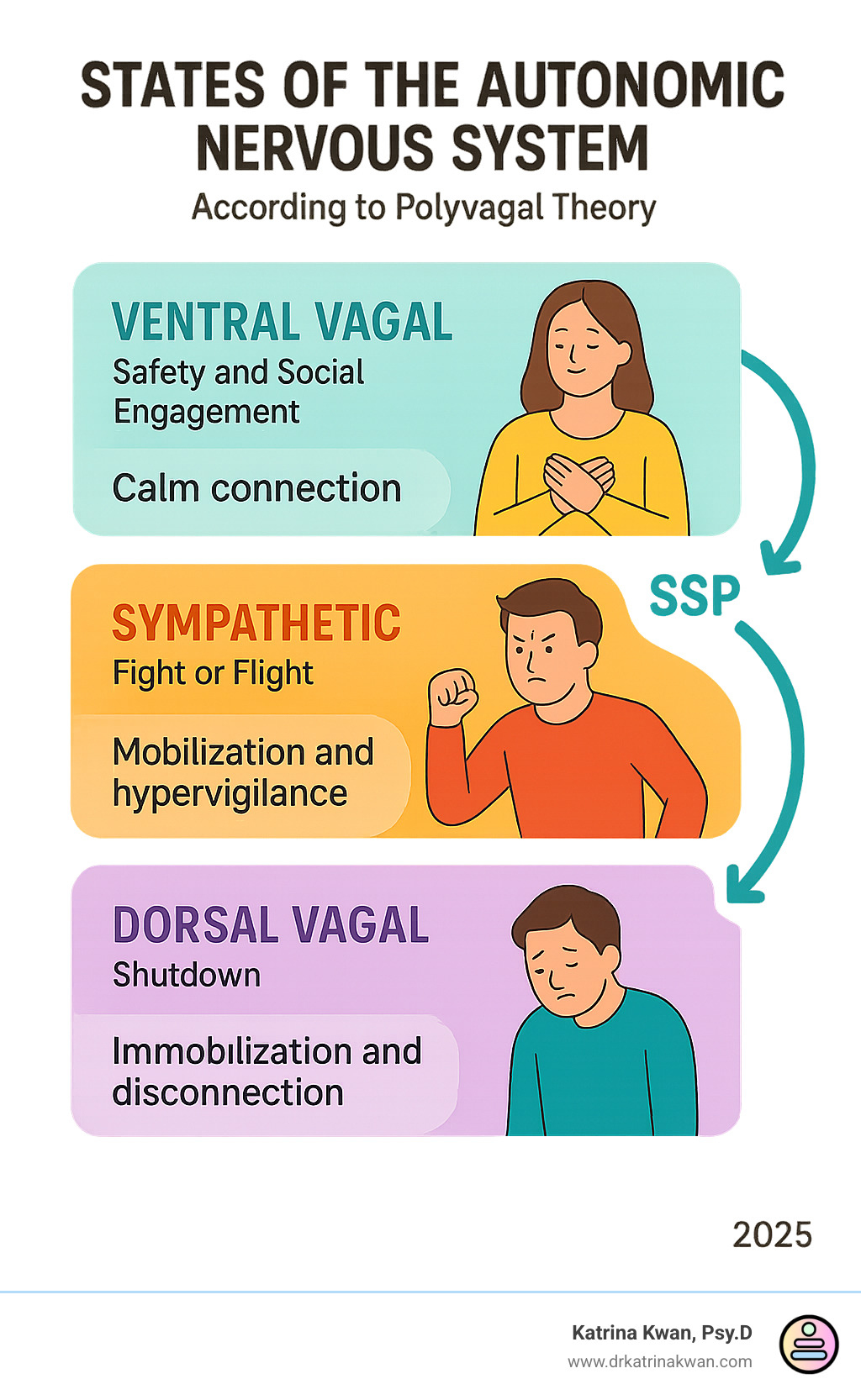Measuring the Effectiveness of Safe and Sound Protocol: The Real Results

Why Safe and Sound Protocol Effectiveness Matters for Your Healing Journey
When adults come to my practice feeling stuck despite trying various approaches, I often hear the same concern: "How do I know if this will actually work?" It's a valid question, especially when you've invested time and energy in healing without seeing the lasting changes you're seeking.
The safe and sound protocol effectiveness is demonstrated through clinical research and real-world applications, showing significant improvements in emotional regulation, social engagement, and trauma recovery. What makes this particularly meaningful is that the safe and sound protocol works differently than traditional talk therapy—it addresses the foundational nervous system patterns that keep you feeling stuck, rather than trying to think your way into feeling different.
In my work with adults who recognize how their history, language, coping skills, thought patterns, temperament, attachment, and personality create limitations, I've observed that most people benefit from approaches that go beyond talking. The sound protocol offers exactly this kind of alternative pathway, working directly with your autonomic nervous system's capacity to recognize safety and shift out of chronic defensive states.
At Katrina Kwan, Psy.D., I view this intervention as a profound shift in how I approach mental health treatment. My focus is on the organizing principles of your nervous system rather than just managing symptoms, helping you build authentic resilience from the ground up.
Understanding What the Research Shows
Clinical research reveals compelling evidence for safe and sound protocol effectiveness across a broad range of conditions and populations:
- 70.3% of participants showed meaningful change in at least one domain within 4 weeks
- Significant improvements in auditory hypersensitivities, emotional control, and behavioral organization
- Reduced trauma-related distress scores, with some cases showing complete resolution of specific traumatic memories
- Increased social awareness and reduced defensive responses in social situations
- Enhanced therapeutic outcomes when combined with other modalities like eye movement desensitization and reprocessing (EMDR), somatic work, and trauma-informed approaches
What strikes me most about these findings is how they align with my clinical observations. The adults I work with often report that the sound protocol SSP creates a foundation that makes other therapy more accessible and effective. Instead of fighting against their nervous system's protective responses, they can begin to work with their innate ability for regulation and connection, supporting their overall well being and sense of safety in life.

What Is the Safe and Sound Protocol and How Does It Work?
The safe and sound protocol is a listening therapy developed by Dr. Stephen Porges based on his polyvagal theory. Rather than focusing on changing your thoughts or behaviors directly, this sound protocol works with your autonomic nervous system's fundamental capacity to distinguish between safety and danger.
Polyvagal theory suggests that your nervous system constantly scans for cues through a process called "neuroception." When it perceives threat—whether real or imagined—it activates survival responses like fight, flight, or freeze. These stress responses can become chronic patterns that interfere with your ability to connect with others, regulate emotions, and access your natural resilience.
The safe and sound protocol uses specially filtered music that emphasizes high frequencies within the range of human speech. This isn't about relaxation music or positive thinking. The filtered music acts as gentle exercise for the tiny muscles in your middle ear, helping retrain your auditory system to better process cues of safety, particularly in the human voice.
This process involves both the central nervous system and autonomic nervous system, working through cranial nerves that connect your middle ear to your brain. The sound protocol SSP helps your nervous system learn to focus on safety cues rather than constantly scanning for danger, improving your ability to engage in healthy social interactions and process emotions more effectively.
In my practice, I've found that many adults carry nervous system patterns shaped by their history—perhaps growing up in environments where vigilance was necessary, or experiencing trauma that taught their system to expect danger. SSP helps retrain these deep-seated patterns through the body rather than trying to override them with cognitive strategies alone.
The Science Behind Sound and Safety
The human voice carries profound significance for our autonomic nervous system. We're evolutionarily wired to find safety in certain frequencies of human speech, yet trauma and chronic stress can alter how we process these sounds. Some of my clients describe feeling triggered or overwhelmed by certain voices, or finding it difficult to truly hear and connect with others even when they want to.
Dr. Stephen Porges' research on polyvagal theory reveals that the social engagement system—a network within the autonomic nervous system—mediates social behavior and emotional regulation by processing cues of safety and danger. The safe and sound protocol works by presenting human voice frequencies in specially filtered music that bypasses existing threat associations.
The filtered music stimulates the neural pathways linked to social engagement while calming the defensive responses that might otherwise be activated. This process involves cranial nerves that play a key role in auditory processing, helping optimize the function of your middle ear muscles and supporting your brain's ability to distinguish between safe and threatening sounds.
This intervention represents what's called a "bottom-up" approach to healing. Instead of starting with thoughts and working down to the body, the sound protocol starts with your nervous system's physiological state and creates the foundation for different thoughts and feelings to emerge naturally. SSP helps create the conditions for authentic emotional regulation rather than forcing change through willpower alone.
Beyond Talk Therapy: Creating Physiological Safety
In my work, I often see adults who are highly intelligent and insightful about their patterns, yet still feel trapped by them. They can understand their trauma responses, recognize their triggers, and even predict when they'll feel overwhelmed—but still find themselves caught in the same cycles.
This is where the limitation of purely cognitive approaches becomes clear. You can't think your way into feeling safe when your nervous system is organized around protection and survival. Your body needs to experience safety at a physiological level before lasting change becomes possible.
The safe and sound protocol addresses this by working directly with the autonomic nervous system—the part of your nervous system that operates below conscious awareness and controls your basic state of activation or calm. When this foundation shifts, other therapy becomes far more accessible and effective.
I integrate the sound protocol with the other modalities I offer—Brainspotting and Somatic Experiencing—because each addresses different aspects of healing. The safe and sound approach creates the nervous system stability that allows for deeper processing, while the other approaches help you learn to read your internal landscape better and respond in ways that align with who you are.
This effective treatment approach recognizes that lasting change requires addressing both the nervous system's organizing principles and developing practical skills for navigating life's challenges. The intervention helps you build capacity for self care and emotional regulation that supports your long-term well being.
Polyvagal Theory and Your Healing Journey
Dr. Stephen Porges' polyvagal theory provides the framework for understanding why the safe and sound protocol is so effective for mental health treatment. According to polyvagal theory, your autonomic nervous system has evolved to constantly assess safety and danger, with your social engagement system representing the most sophisticated level of this assessment.
When your social engagement system is online, you can connect with others, think clearly, and access your natural resilience. When it's offline—due to trauma, chronic stress, or other factors—you default to older survival systems that prioritize protection over connection.
The sound protocol specifically targets the neural pathways that support social engagement. By working with the auditory system's connection to the vagus nerve, SSP helps shift your nervous system from defensive states toward states of calm and connection. This process supports healthy social interactions and improves your ability to navigate social situations with greater ease.
In my practice, I see this shift as fundamental to the kind of deep, lasting change my clients are seeking. It's not about eliminating your natural protective responses—these serve important functions. Instead, it's about expanding your capacity to recognize when safety is actually present and respond accordingly, supporting both your mental health and your relationships.
The safe and sound approach works with the organizing principles of your nervous system, helping you develop a more flexible and responsive relationship with stress and challenge. This foundation supports all areas of your life, from your ability to focus and make decisions to your capacity for intimacy and connection.

Clinical Evidence Across Different Challenges
The research on safe and sound protocol effectiveness spans multiple populations and presenting concerns that align closely with the issues I address in my practice:
Trauma and PTSD: The sound protocol helps regulate nervous systems stuck in chronic fight, flight, or freeze responses. SSP helps support the process of traumatic memories and sensations by creating a foundation of physiological safety that makes this work less overwhelming and more sustainable. Trauma survivors often report improved sleep quality and reduced hypervigilance after completing the listening sessions.
Anxiety and Stress Responses: Many adults I work with describe feeling "always on alert," scanning for potential threats even in safe environments. The safe and sound protocol helps calm these hypervigilant states by retraining the nervous system to recognize genuine safety cues. SSP helps reduce anxiety by addressing its roots in the autonomic nervous system rather than just managing symptoms.
Autism Spectrum Disorders and Sensory Processing: Research shows improvements in sound processing, social awareness, and reduced sensory sensitivity. Importantly, the sound protocol doesn't aim to eliminate autistic traits but supports individuals in managing sensory processing challenges and social difficulties more effectively. The safe and sound approach helps people with autism develop greater comfort in social situations while honoring their neurodivergent brain function.
Emotional Regulation and Behavioral Function: Clinical studies demonstrate significant improvements in emotional regulation and behavioral organization. This aligns with what I observe—clients develop greater ability to feel their emotions without being overwhelmed by them. SSP helps address emotional dysregulation by working with the nervous system patterns that underlie these challenges.
Auditory Hypersensitivities and Sensory Processing: For those who struggle with certain frequencies or find human voices triggering, the safe and sound protocol offers a gradual, safe way to rebuild tolerance and connection. The specially filtered music helps retrain the middle ear muscles and cranial nerves involved in auditory processing.
Long-Term Benefits and Building Resilience
What makes the safe and sound protocol particularly valuable is its focus on building lasting resilience rather than just symptom relief. The adults I work with aren't looking for quick fixes—they want sustainable changes that align with their authentic selves and support their long-term well being.
The long-term benefits of this intervention include:
Expanded Window of Tolerance: Your ability to handle stress and challenging emotions increases, making overwhelming situations more manageable. SSP helps expand your capacity to respond rather than react to life's challenges.
Sustainable Regulation: Your autonomic nervous system learns to maintain calm and groundedness even when facing stressors, without requiring constant conscious effort. This foundation supports your mental health and relationships over time.
Enhanced Therapeutic Receptivity: A regulated nervous system is more open to other forms of healing work, making subsequent therapy more effective and efficient. The sound protocol creates the foundation for deeper processing and integration.
Deeper Sense of Embodied Safety: Rather than just thinking you're safe, you begin to feel genuinely safe in your own body and in connection with others. This feeling safe extends to your relationships and social situations.
Improved Relationship Capacity: As your nervous system becomes less reactive, you can engage more authentically in relationships without constant vigilance or defensive responses. Your ability to connect and communicate improves naturally.
Access to Natural Resilience: You reconnect with innate capacities for healing and growth that may have been suppressed by chronic stress or trauma. The safe and sound approach helps you rediscover your own resources and strengths.
Better Sleep Quality and Daily Function: Many clients report improvements in sleep patterns, focus, and overall daily function as their nervous system learns to regulate more effectively.

SSP for Trauma: Retraining Your System for Safety
Trauma, particularly developmental and relational trauma, can leave your nervous system in a state of chronic hypervigilance. For many trauma survivors, even safe human voices can trigger defensive responses based on past experiences of harm.
This creates a challenging paradox—the very connections that could support healing feel threatening to a system organized around protection. The safe and sound protocol offers a unique solution by reintroducing human voice frequencies in carefully filtered music that feels non-threatening to your nervous system.
For clients who find human voices triggering, I often begin with non-vocal playlists that use the same filtration technology focusing on high frequencies and certain frequencies that support regulation. This allows for a gentle entry point that respects where your nervous system is while gradually building capacity for human connection.
The process isn't about forcing yourself to feel safe, but about creating conditions where safety can be genuinely experienced and integrated. This distinction is crucial—it honors your system's protective wisdom while creating opportunities for new experiences. SSP helps your brain and nervous system learn that safety is possible, supporting the process of healing trauma at its roots.
Integrating SSP with Other Healing Approaches
In my practice, the safe and sound protocol is never a standalone intervention. I integrate it with Brainspotting, Somatic Experiencing, and Accelerated Resourcing based on what makes sense for each individual's healing journey and goals.
The sound protocol often serves as preparation for deeper processing work. By creating nervous system stability first, other approaches become safer and more effective. Clients report being able to access and process material that previously felt too overwhelming or activating.
This integration reflects my approach of building on what's already working for you rather than trying to impose external solutions. The safe and sound approach supports your nervous system's natural capacity for regulation, while other modalities help you learn to navigate your internal landscape and respond in ways that align with your authentic self.
When combined with eye movement desensitization and reprocessing (EMDR) or other trauma therapies, SSP helps create the foundation of safety that makes deeper work possible. The intervention prepares your nervous system to process traumatic material without becoming overwhelmed or re-traumatized.
This comprehensive treatment plan recognizes that healing happens on multiple levels—physiological, emotional, cognitive, and relational. The safe and sound protocol addresses the foundational nervous system patterns, while other approaches help you develop new skills and insights for navigating your life.
What to Expect During Your SSP Journey
The safe and sound protocol consists of five hours of listening to specially filtered music, typically broken into shorter sessions over several days or weeks. The pacing is individualized based on your nervous system's capacity and response.
Some people notice immediate calming effects and improved sleep quality, while for others, changes unfold more gradually over the weeks following completion. The integration period is often when the most significant shifts occur, as your nervous system incorporates new patterns of regulation and response.
During our work together, I pay close attention to how your system responds and adjust the pacing accordingly. This isn't about pushing through or following a rigid schedule—it's about honoring your nervous system's wisdom and capacity while creating opportunities for growth.
The listening process itself is gentle and non-invasive. You simply listen to the filtered music through headphones while engaging in quiet activities like reading, drawing, or resting. Many clients find the process surprisingly relaxing and restorative.
Follow up sessions help track your progress and address any questions or concerns that arise during the integration period. This ongoing support ensures that you're getting the maximum benefit from the intervention and helps identify when additional approaches might be helpful.
Follow-Up and Continued Growth
Completing the safe and sound protocol marks the beginning rather than the end of your healing journey. I work with clients to track changes in emotional regulation, social engagement, sensory sensitivity, and overall well being through regular follow up appointments.
This ongoing relationship allows me to understand how your nervous system continues to evolve and where additional support might be helpful. Some clients find that the sound protocol opens doors to processing work that previously felt inaccessible, while others discover new capacities for connection and resilience.
The goal isn't to create dependence on treatment but to support your growing ability to read your internal landscape and respond in ways that serve your authentic self and long-term well being. Follow up sessions often reveal improvements in relationships, work performance, sleep quality, and overall life satisfaction.
Many clients find that booster sessions several months later help maintain and deepen the benefits, particularly for those with complex trauma histories. The safe and sound approach provides a foundation that continues to support growth and healing over time.
Frequently Asked Questions About SSP
Is the safe and sound protocol right for everyone? The sound protocol can benefit many adults dealing with challenges related to emotional regulation, social engagement, or trauma responses. However, it's not a one-size-fits-all solution. During our initial consultation, I assess whether this intervention aligns with your goals and current capacity. Most people find the process supportive and beneficial, though individual responses vary.
How does the safe and sound protocol work with other therapy I'm receiving? SSP helps often enhances other therapeutic work by creating nervous system stability. I coordinate with other providers when appropriate to ensure all aspects of your care work together harmoniously. The intervention provides a foundation that supports the effectiveness of other treatment approaches.
What if I don't like listening to music or sounds? The specially filtered music used in the sound protocol is quite different from regular music. For those with significant sensory sensitivity, I start very gradually and adjust based on your system's response. Non-vocal options focusing on certain frequencies are available for those who find voices particularly challenging.
How long do the effects last? Many people experience lasting changes from the safe and sound protocol, particularly when combined with ongoing therapeutic support. The nervous system changes create a foundation that continues to support growth and resilience over time. Regular follow up helps maintain and build on these benefits.
Can SSP help with autism and sensory processing issues? Research shows that the sound protocol can be helpful for people with autism spectrum disorders and sensory processing challenges. SSP helps doesn't aim to change autistic traits but supports individuals in managing sensory sensitivity and social difficulties more effectively. The intervention can improve function and comfort in social situations while honoring neurodivergent brain patterns.
Finding Your Foundation of Safety
The effectiveness of the safe and sound protocol lies not in changing who you are, but in supporting your nervous system's natural capacity for regulation and connection. When your body can genuinely recognize safety, everything else becomes possible—deeper relationships, more authentic self-expression, and access to your innate resilience and wisdom.
In my practice, I've witnessed how the sound protocol creates space for people to become more fully themselves rather than constantly managing protective responses. This shift allows for the kind of sustainable change that aligns with your authentic self and supports long-term well being and mental health.
The safe and sound approach helps you develop the ability to respond to life's challenges from a place of calm and clarity rather than reactivity and fear. This foundation supports not just your therapy process but your relationships, work life, and overall sense of fulfillment and connection.
If you're curious about whether the safe and sound protocol might support your healing journey, I invite you to reach out for a consultation. Together, we can explore how this intervention might fit with your unique needs, goals, and vision for your life.
My online therapy services are available to adults in Washington State and Utah who are ready to explore what becomes possible when your nervous system finally has permission to feel genuinely safe.
Ready to learn more about how somatic approaches can support your healing? Contact my practice to schedule a consultation and discover what becomes possible when your body and nervous system are truly supported in their natural capacity for resilience and connection.
